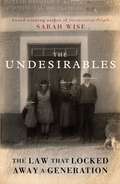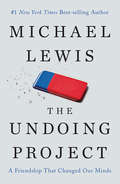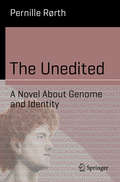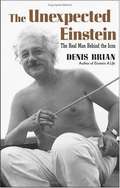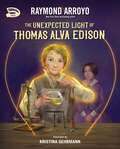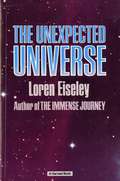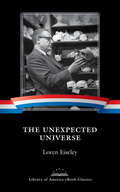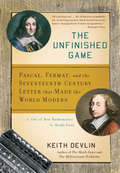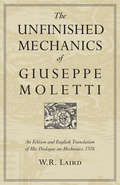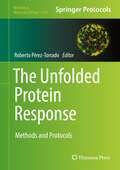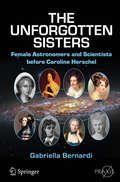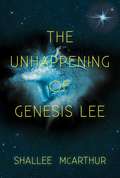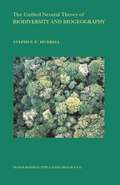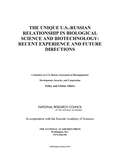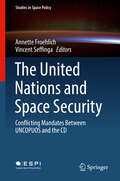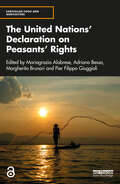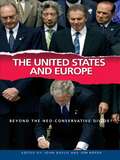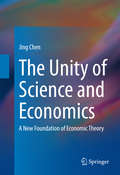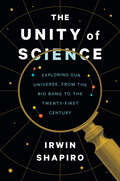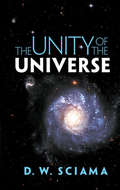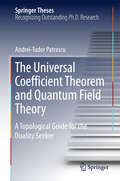- Table View
- List View
The Undesirables: The Law that Locked Away a Generation
by Sarah WiseThrough the early twentieth century, the British Government locked away over 50,000 innocent people. Their &‘crimes&’? Being poor and unyielding. This is their story. 'The heartrending stories Sarah Wise has unearthed beggar belief… beautifully researched and truly compelling.' Catherine Bailey, author of Black Diamonds By 1950, an estimated 50,000 people had been deemed &‘defective&’ by the British government and detained indefinitely under the 1913 Mental Deficiency Act. Their &‘crimes&’ were various: women with children born out of wedlock; rebellious teenagers caught shoplifting; those with epilepsy, hearing impairments and chronic illnesses who had struggled in school; and many who were simply &‘different&’. Forcibly removed from their families and confined to a shadow world of specialist facilities in the countryside, they were hidden away and forgotten – out of sight, out of mind. Through painstaking archival research, award-winning historian Sarah Wise shines a light on this shameful chapter. Piecing together the lives irrevocably changed by this devastating legislation, The Undesirables provides a compelling study of how early twentieth-century attitudes to class, gender and disability resulted in a nationwide scandal – and how they continue to shape social policy to this day.
The Undoing Project: A Friendship That Changed Our Minds
by Michael Lewis<P>How a Nobel Prize-winning theory of the mind altered our perception of reality. <P>Forty years ago, Israeli psychologists Daniel Kahneman and Amos Tversky wrote a series of breathtakingly original studies undoing our assumptions about the decision-making process. Their papers showed the ways in which the human mind erred, systematically, when forced to make judgments in uncertain situations. Their work created the field of behavioral economics, revolutionized Big Data studies, advanced evidence-based medicine, led to a new approach to government regulation, and made much of Michael Lewis's own work possible. Kahneman and Tversky are more responsible than anybody for the powerful trend to mistrust human intuition and defer to algorithms. <P>The Undoing Project is about a compelling collaboration between two men who have the dimensions of great literary figures. They became heroes in the university and on the battlefield--both had important careers in the Israeli military--and their research was deeply linked to their extraordinary life experiences. Amos Tversky was a brilliant, self-confident warrior and extrovert, the center of rapt attention in any room; Kahneman, a fugitive from the Nazis in his childhood, was an introvert whose questing self-doubt was the seedbed of his ideas. They became one of the greatest partnerships in the history of science, working together so closely that they couldn't remember whose brain originated which ideas, or who should claim credit. They flipped a coin to decide the lead authorship on the first paper they wrote, and simply alternated thereafter. <P>This story about the workings of the human mind is explored through the personalities of two fascinating individuals so fundamentally different from each other that they seem unlikely friends or colleagues. In the process they may well have changed, for good, mankind's view of its own mind. <P><b>A New York Times Bestseller</b>
The Unedited: A Novel About Genome and Identity (Science and Fiction)
by Pernille RørthThis novel is set in the near future, where human genome editing has become routine. First adopted to fight a lethal virus, it is now widely used to prevent diseases and favor other traits. Ben, Eiko, Celia, Raphael and Leo have just had their coming-of-age genome reading and are struggling with this new information for each their own reasons. Soon, they are cast into the middle of a crisis that threatens the future of their society and pits it against a parallel, but strictly separated, society where genome manipulation is forbidden on religious grounds. The book includes an essay on the potential of human genome engineering and related genome-based choices.
The Unexpected Einstein: The Real Man Behind The Icon
by Denis BrianA fascinating book that exposes the many myths about the great scientist. Acclaimed biographer Denis Brian takes on the many myths surrounding the eccentric genius--that he was a woman hater and plagiarist who stole other scientists' ideas, that he didn't speak until he was four or five--many of which were circulated and published while he was still alive. Featuring never-before published interviews and photos, this entertaining and informative book reveals many unexpected facets of Einstein's life--such as his culinary exploits--as it captures the man behind the myths.
The Unexpected Light of Thomas Alva Edison (Turnabout Tales)
by Raymond ArroyoFrom New York Times bestselling author and news anchor Raymond Arroyo comes the first book in the Turnabout Tales series—a picture book biography of one of America&’s most famous inventors, Thomas Alva Edison, and a story about how a small spark can create a big light.No one thought much of young Thomas Alva Edison. He couldn&’t focus at school and caused trouble around the house. But where others saw a distracted and mischievous boy, his mother saw imagination and curiosity. At only seven years old, Al, as he was called as a young child, was educated by his mother, who oversaw his rigorous at-home education while also allowing him great freedom to explore and dream. Those early years of encouragement and loving guidance formed the man who would apply those valuable lessons as well as his rich imagination to inventing the phonograph, the motion picture camera, the light bulb, and more.In The Unexpected Light of Thomas Alva Edison readers will:meet the larger-than-life personality of Thomas Alva Edisonhear an inspiring tale of an underdog overcoming all the oddslearn about the power of curiosity and imaginationtake a carefully researched and actively told romp through history The Unexpected Light of Thomas Alva Edison includes:an annotated list of resources and suggested readingrealistic illustrations by artist Kristina Gehrmannan author&’s note by Raymond Arroyo, the author of the bestselling The Spider Who Saved Christmas The Turnabout Tales series highlights little-known yet fascinating stories of historical figures who went from underdog to hero, and the adults who inspired them to be true to themselves and do big things that changed the world.
The Unexpected Universe
by Loren C. EiseleyDrawing from his long experience as a naturalist, the author responds to the unexpected and symbolic aspects of a wide spectrum of phenomena throughout the universe. Scrupulous scholarship and magical prose are brought to bear on such diverse topics as seeds, the hieroglyphs on shells, lost tombs, the goddess Circe, city dumps, and Neanderthal man.
The Unexpected Universe: A Library of America eBook Classic
by Loren Eiseley William CrononAt the height of a distinguished career as a paleontologist, Loren Eiseley turned from fieldwork and scientific publication to the personal essay. Here, in The Unexpected Universe, he displays his far-reaching knowledge and searching curiosity about the natural world, and the qualities that led many to hail him as a "modern Thoreau." Fascinating accounts of the journeys of Odysseus, Captain Cook, and Charles Darwin frame Eiseley's more modest wanderings as a suburban naturalist, attentive to the lives of small creatures. Sometimes he travels no further than the local dump: and yet, like Homer's hero or these great explorers, he continually finds a universe "not only queerer than we suppose, but queerer than we can suppose."
The Unfinished Game: Pascal, Fermat, and the Seventeenth-Century Letter that Made the World Modern
by Keith DevlinIn the early seventeenth century, the outcome of something as simple as a dice roll was consigned to the realm of unknowable chance. Mathematicians largely agreed that it was impossible to predict the probability of an occurrence. Then, in 1654, Blaise Pascal wrote to Pierre de Fermat explaining that he had discovered how to calculate risk. The two collaborated to develop what is now known as probability theory?a concept that allows us to think rationally about decisions and events. In "The Unfinished Game," Keith Devlin masterfully chronicles Pascal and FermatOCOs mathematical breakthrough, connecting a centuries-old discovery with its remarkable impact on the modern world.
The Unfinished Mechanics of Giuseppe Moletti
by W. R. LairdMechanics has long been recognized as the pivotal science in the decline of Aristotelian natural philosophy and the rise of the new, mathematical physics of the Scientific Revolution. Less well known, however, is the earlier transformation of mechanics from a practical art into a theoretical and mathematical science. This transformation was occasioned by the recovery of the pseudo-Aristotelian Mechanical Problems and its assimilation in the course of the sixteenth century to the Aristotelian model of the subalternate or middle sciences, which deal with natural subject matter but draw their principles from geometry or arithmetic.In his Dialogue on Mechanics, Giuseppe Moletti made the most explicit and thoroughgoing attempt to determine the geometrical principles of Aristotelian mechanics, to establish its Euclidean foundations, and so to realize in fact the subalternation of mechanics to geometry. Having done this in the First Day, he then set out in the Second to extend mechanics generally to explain all motions through the analysis of their forces and resistances. In the process he anticipated Galileo in asserting that all heavy bodies, whatever their weights, fall with equal speeds, and he realized that the same resistance that makes a body hard to move also makes it hard to stop - which is almost the law of inertia.Written in dialogue form in Italian (rather than in Latin) for a courtly and practical audience, the Dialogue was left unfinished when Moletti quit the Gonzaga court at Mantua to take up the mathematics chair at the University of Padua. Never before published except for brief extracts, the full Italian text is edited from the manuscripts and printed here for the first time, together with a facing-page English translation. The extensive notes that accompany the text cite and quote from a number of Moletti's other, mostly unpublished, works and his numerous sources. In his introduction, W.R. Laird sets the Dialogue within the historical background of medieval and Renaissance mechanics, sketches the life and works of Moletti, and analyses the arguments and the geometrical theorems of the Dialogue.The Unfinished Mechanics of Giuseppe Moletti offers an unprecedented look at the transformation of Aristotelian mechanics into a mathematical science in the generation before Galileo.
The Unfolded Protein Response: Methods and Protocols (Methods in Molecular Biology #2378)
by Roberto Pérez-TorradoThis volume is divided in six section covering the most experimental approaches involved in the study of the unfolded protein response (UPR) pathway. Chapters detail determination of unfolded protein levels, methods to study UPR signal transmission, analysing the outcomes of the UPR pathway activation, UPR studies in mammalian models, UPR in alternative models, and UPR and disease. Written in the format of the highly successful Methods in Molecular Biology series, each chapter includes an introduction to the topic, lists necessary materials and reagents, includes tips on troubleshooting and known pitfalls, and step-by-step, readily reproducible protocols. Authoritative and cutting-edge, The Unfolded Protein Response: Methods and Protocols aims to describe key methods and approaches used in the study of the UPR pathway and its complex cellular implications.Chapter 6 is available open access under a Creative Commons Attribution 4.0 International License via link.springer.com.
The Unforgotten Sisters
by Gabriella BernardiTakinginspiration from Siv Cedering's poem in the form of a fictional letter fromCaroline Herschel that refers to "my long, lost sisters, forgotten in the booksthat record our science", this book tells the lives of twenty-five femalescientists, with specific attention to astronomers and mathematicians. Each ofthe presented biographies is organized as a kind of "personal file"which sets the biographee's life in its historical context, documents her mainworks, highlights some curious facts, and records citations about her. Theselected figures are among the most representative of this neglected world,including such luminaries as Hypatia of Alexandra, Hildegard of Bingen,Elisabetha Hevelius, and Maria Gaetana Agnesi. They span a period of about 4000years, from En HeduAnna, the Akkadian princess, who was one of the firstrecognized female astronomers, to the dawn of the era of modern astronomy withCaroline Herschel and Mary Somerville. The book will be of interest to allwho wish to learn more about the women from antiquity to the nineteenth centurywho played such key roles in the history of astronomy and science despiteliving and working in largely male-dominated worlds.
The Unhappening of Genesis Lee
by Shallee McarthurWhat would it feel like to never forget? Or to have a memory stolen?Seventeen-year-old Genesis Lee has never forgotten anything. As one of the Mementi-a small group of genetically enhanced humans-Gena remembers everything with the help of her Link bracelets, which preserve them perfectly. But Links can be stolen, and six people have already lost their lives to a memory thief, including Gena's best friend.Anyone could be next. That's why Gena is less than pleased to meet a strange but charming boy named Kalan who claims not only that they have met before, but also that Gena knows who the thief is.The problem is that Gena doesn't remember Kalan, she doesn't remember seeing the thief, and she doesn't know why she's forgetting things-or how much else she might forget. As growing tensions between Mementi and ordinary humans drive the city of Havendale into chaos, Gena and Kalan team up to search for the thief. And as Gena loses more memories, they realize they have to solve the mystery fast...because Gena's life is unhappening around her.
The Unified Neutral Theory of Biodiversity and Biogeography (Monographs in Population Biology #32)
by Stephen P. HubbellDespite its supreme importance and the threat of its global crash, biodiversity remains poorly understood both empirically and theoretically. This ambitious book presents a new, general neutral theory to explain the origin, maintenance, and loss of biodiversity in a biogeographic context. Until now biogeography (the study of the geographic distribution of species) and biodiversity (the study of species richness and relative species abundance) have had largely disjunct intellectual histories. In this book, Stephen Hubbell develops a formal mathematical theory that unifies these two fields. When a speciation process is incorporated into Robert H. MacArthur and Edward O. Wilson's now classical theory of island biogeography, the generalized theory predicts the existence of a universal, dimensionless biodiversity number. In the theory, this fundamental biodiversity number, together with the migration or dispersal rate, completely determines the steady-state distribution of species richness and relative species abundance on local to large geographic spatial scales and short-term to evolutionary time scales. Although neutral, Hubbell's theory is nevertheless able to generate many nonobvious, testable, and remarkably accurate quantitative predictions about biodiversity and biogeography. In many ways Hubbell's theory is the ecological analog to the neutral theory of genetic drift in genetics. The unified neutral theory of biogeography and biodiversity should stimulate research in new theoretical and empirical directions by ecologists, evolutionary biologists, and biogeographers.
The Uninhabitable Earth: Life After Warming
by David Wallace-WellsIt is worse, much worse, than you think. If your anxiety about global warming is dominated by fears of sea-level rise, you are barely scratching the surface of what terrors are possible. In California, wildfires now rage year-round, destroying thousands of homes. Across the US, “500-year” storms pummel communities month after month, and floods displace tens of millions annually. <p><p> This is only a preview of the changes to come. And they are coming fast. Without a revolution in how billions of humans conduct their lives, parts of the Earth could become close to uninhabitable, and other parts horrifically inhospitable, as soon as the end of this century. <p> In his travelogue of our near future, David Wallace-Wells brings into stark relief the climate troubles that await—food shortages, refugee emergencies, and other crises that will reshape the globe. But the world will be remade by warming in more profound ways as well, transforming our politics, our culture, our relationship to technology, and our sense of history. It will be all-encompassing, shaping and distorting nearly every aspect of human life as it is lived today. <p> Like An Inconvenient Truth and Silent Spring before it, The Uninhabitable Earth is both a meditation on the devastation we have brought upon ourselves and an impassioned call to action. For just as the world was brought to the brink of catastrophe within the span of a lifetime, the responsibility to avoid it now belongs to a single generation. <p><b>A New York Times Bestseller</b>
The Unique U.S.-Russian Relationship in Biological Science and Biotechnology
by National Research Council Policy and Global Affairs Development, Security, and Cooperation Russian Academy of Sciences Committee on U.S.-Russian BioengagementIn the fall of 2010, the U.S. National Academies (consisting of the National Academy of Sciences, the National Academy of Engineering, and the Institute of Medicine) and the Russian Academy of Sciences (in cooperation with the Russian Academy of Medical Sciences and the Russian Academy of Agricultural Sciences) initiated a joint study of U.S.-Russian bilateral engagement in the biological sciences and biotechnology (hereinafter collectively referred to as bioengagement). The U.S. Department of State and the Russian Academy of Sciences provided support for the study. The academies established a joint committee of 12 leading scientists from the two countries to assess bioengagement activities since 1996 and to provide recommendations as to collaborative efforts in the near future. The Unique U.S.-Russian Relationship in Biological Science and Biotechnology: Recent Experience and Future Directions summarizes the principal conclusions and recommendations of the study.
The United Nations and Space Security: Conflicting Mandates between UNCOPUOS and the CD (Studies in Space Policy #21)
by Annette Froehlich Vincent SeffingaThis book provides a detailed analysis on the history and development of the Committee on the Peaceful Uses of Outer Space (UNCOPUOS) and the Conference on Disarmament (CD) and the coordination and cooperation between these two fora. Furthermore, it discusses the future challenges that these fora will have to deal with and conclude in which way the current system can change to cope with the evolution of space matters. This is necessary for the proper discussion of space matters because these matters cannot simply be divided between military and non-military, but are interrelated.
The United Nations' Declaration on Peasants' Rights (Earthscan Food and Agriculture)
by Mariagrazia Alabrese Margherita Brunori Adriana Bessa Pier Filippo GiuggioliThis is the first book to address and review the United Nations' Declaration on the Rights of Peasants and Other People Working in Rural Areas (UNDROP), which was adopted by the United Nations General Assembly in December 2018. Food security and sustainable agri-food systems, responsible governance of natural resources, and human rights are among the key themes of the new millennium. The Declaration is the first internationally negotiated instrument bridging these issues, calling for a radical paradigm change in the agricultural sector while giving voice to peasants and rural workers, recognised as the drivers of more equitable and resilient food systems. The book unfolds the impact of the Declaration in the wider realm of law and policy making, especially concerning the new human rights standards related to access and control of natural resources and the governance of food systems. The chapters in the book touch on a broad array of topics, including women’s rights, the role of and impact on indigenous peoples, food sovereignty, climate change, land tenure, and agrobiodiversity. Voices from outstanding scholars and practitioners are gathered together to inform and trigger a further debate on the negotiation process, the innovative and potentially disruptive contents, the relations with other fields of law, and the practical scope of the Declaration. The volume concludes with a collection of case studies that provide concrete examples to help us understand the potential impacts of the Declaration at regional, national, and local levels. This book is the first comprehensive tool to navigate the Declaration and is designed for students, researchers, and practitioners in the fields of food and agriculture law, peasant, agrarian and rural studies, human rights and environmental law, and international development and cooperation.
The United States and Europe: Beyond the Neo-Conservative Divide? (Contemporary Security Studies)
by Jon Roper John BaylisA penetrating new examination of the triangular political and cultural relationship between America, Britain, and continental Europe. This relationship is both fraught and dynamic. Post-war reconstruction of Europe brought integration. Creating a ‘United States of Europe’ was a goal shared by many Americans. Yet the contemporary 'War on Terror', has redefined relationships between America, Britain, 'old' and 'new' Europe. For Britain, the Channel seems wider than the Atlantic, although geopolitically it is part of Europe. This book brings together experts from Britain, Europe and America to explore the complexities of contemporary cultural and political relationships, considering the challenges that have been met and those that have to be faced.
The Unity of Science and Economics
by Jing ChenThis book presents a new economic theory developed from physical and biological principles. It explains how technology, social systems and economic values are intimately related to resources. Many people have recognized that mainstream (neoclassical) economic theories are not consistent with physical laws and often not consistent with empirical patterns, but most feel that economic activities are too complex to be described by a simple and coherent mathematical theory. While social systems are indeed complex, all life systems, including social systems, satisfy two principles. First, all systems need to extract resources from the external environment to compensate for their consumption. Second, for a system to be viable, the amount of resource extraction has to be no less than the level of consumption. From these two principles, we derive a quantitative theory of major factors in economic activities, such as fixed cost, variable cost, discount rate, uncertainty and duration. The mathematical theory enables us to systematically measure the effectiveness of different policies and institutional structures at varying levels of resource abundance and cost. The theory presented in this book shows that there do not exist universally optimal policies or institutional structures. Instead, the impacts of different policies or social structures have to be measured within the context of existing levels of resource abundance. As the physical costs of extracting resources rise steadily, many policy assumptions adopted in mainstream economic theories, and workable in times of cheap and abundant energy supplies and other resources, need to be reconsidered. In this rapidly changing world, the theory presented here provides a solid foundation for examining the long-term impacts of today's policy decisions.
The Unity of Science: Exploring Our Universe, from the Big Bang to the Twenty-First Century
by Irwin ShapiroA journey guided by science that explores the universe, the earth, and the story of life For Irwin Shapiro, science starts with questions. This book provides a broad and entertaining survey of major scientific discoveries that have changed our views of nature and, in turn, spawned further questions. Shapiro, an award-winning scientist and beloved teacher, separates his inquiry into three parts: looking up at the universe; looking down at the earth and its fossils; and looking in at the story of life. His framework encourages readers to view science as a detective story—to observe and question nature and natural phenomena, and to base all conclusions on scientific evidence. With his knowledgeable yet conversational approach, Shapiro offers an enjoyable way for the curious to learn about the foundations of a range of scientific topics: the motions of bodies in the cosmos, the history and structure of the earth, the evolution of organisms, and the search for extraterrestrial life and intelligence.
The Unity of the Universe
by D. W. SciamaDoes the universe consist of independent objects, or is it a single unit? Are some of its features accidental, or can they all be explained in theoretical terms? This accessible book on cosmology addresses profound questions about the universe, and it offers elegant answers in simple, straightforward terms. Written by a distinguished cosmologist, it assumes no knowledge of physics or astronomy and illustrates its explanations with figures and compelling photos. The first part ventures back to the early Greek astronomers, who were the first to measure the Earth's size and the distance to the sun and the moon. It also examines the latter-day discoveries of distant galaxies, achieved with giant telescopes and mathematical calculations. The second part explores modern theories, including the author's own conviction that the universe is a single unit and that the behavior of nearby matter is strongly influenced by distant regions of the universe. A student of Fred Hoyle and Paul Dirac and a teacher of Stephen Hawking, D. W. Sciama is best known for his work on general relativity and black holes. Scientific American acclaimed his survey as "an engrossing book" and "an invigorating intellectual exercise that any mature reader can enjoy."
The Universal Coefficient Theorem and Quantum Field Theory
by Andrei-Tudor PatrascuThis thesis describes a new connection between algebraic geometry, topology, number theory and quantum field theory. It offers a pedagogical introduction to algebraic topology, allowing readers to rapidly develop basic skills, and it also presents original ideas to inspire new research in the quest for dualities. Its ambitious goal is to construct a method based on the universal coefficient theorem for identifying new dualities connecting different domains of quantum field theory. This thesis opens a new area of research in the domain of non-perturbative physics one in which the use of different coefficient structures in (co)homology may lead to previously unknown connections between different regimes of quantum field theories. The origin of dualities is an issue in fundamental physics that continues to puzzle the research community with unexpected results like the AdS/CFT duality or the ER-EPR conjecture. This thesis analyzes these observations from a novel and original point of view, mainly based on a fundamental connection between number theory and topology. Beyond its scientific qualities, it also offers a pedagogical introduction to advanced mathematics and its connection with physics. This makes it a valuable resource for students in mathematical physics and researchers wanting to gain insights into (co)homology theories with coefficients or the way in which Grothendieck's work may be connected with physics. "
The Universal Timekeepers: Reconstructing History Atom by Atom
by David HelfandAtoms are unfathomably tiny. It takes fifteen million trillion of them to make up a single poppy seed—give or take a few billion. And there’s hardly anything to them: atoms are more than 99.9999999999 percent empty space. Yet scientists have learned to count these slivers of near nothingness with precision and to peer into their internal states. In looking so closely, we have learned that atoms, because of their inimitable signatures and imperturbable internal clocks, are little archives holding the secrets of the past.David J. Helfand reconstructs the history of the universe—back to its first microsecond 13.8 billion years ago—with the help of atoms. He shows how, by using detectors and reactors, microscopes and telescopes, we can decode the tales these infinitesimal particles tell, answering questions such as: Is a medieval illustrated prayer book real or forged? How did maize cultivation spread from the highlands of central Mexico to New England? What was Earth’s climate like before humans emerged? Where can we find clues to identify the culprit in the demise of the dinosaurs? When did our planet and solar system form? Can we trace the births of atoms in the cores of massive stars or even glimpse the origins of the universe itself?A lively and inviting introduction to the building blocks of everything we know, The Universal Timekeepers demonstrates the power of science to unveil the mysteries of unreachably remote times and places.
The Universe
by John Brockman<P>Explore the universe with today's greatest physicists.In the wake of one of the most groundbreaking scientific breakthroughs in modern times, the March 2014 discovery of gravitational ripples from the Big Bang--an apparent confirmation of Alan Guth and Andrei Linde's theory of cosmic inflation--John Brockman of Edge.org has gathered together some of the world's best minds to explain the universe as we currently know it. <P>The contributors--many pioneering theoretical physicists and cosmologists, including Guth and Linde--provide an extraordinary picture of cosmology as it has developed over the past three decades. <P>Alan Guth and Andrei Linde explain the Inflationary Universe theory. <P>Lee Smolin discusses the nature of time. <P>Lisa Randall and Neil Turok elaborate on the theory of branes, two-dimensional structures arising from string theory--whose existence is central to the cyclic universe. <P>Seth Lloyd investigates how the universe behaves like a self-programming computer. <P>Lawrence Krauss provides fresh insight into gravity, dark matter, and the energy of empty space. <P>Brian Greene and Einstein biographer Walter Isaacson speculate on how Albert Einstein might view the theoretical physics of the twenty-first century. <P>The late Benoit Mandelbrot looks back on a long career devoted to fractal geometry. <P>Plus Nobel Prize winner Frank Wilczek, Astronomer Royal MaRtin Rees, Caltech physicist Sean Carroll, Stanford's Leonard Susskind, Oxford's David Deutsch, Cornell's Steven Strogatz, Albert Einstein Professor in Science at Princeton Paul Steinhardt, and more! <P><b>A New York Times Bestseller</b>
The Universe
by Seymour SimonImagine the biggest thing you can think of—now imagine something bigger that hasn't even stopped growing. That is the universe. Our own galaxy, the Milky Way, though enormous, is a tiny speck among the 100 billion galaxies containing nebulas, planets, "space pods," billions of stars, and black holes that fill the cosmos. New stars, planets, and galaxies continue to form as the universe expands. Award-winning science writer Seymour Simon brings you deep into the universe to explore this immense topic.
